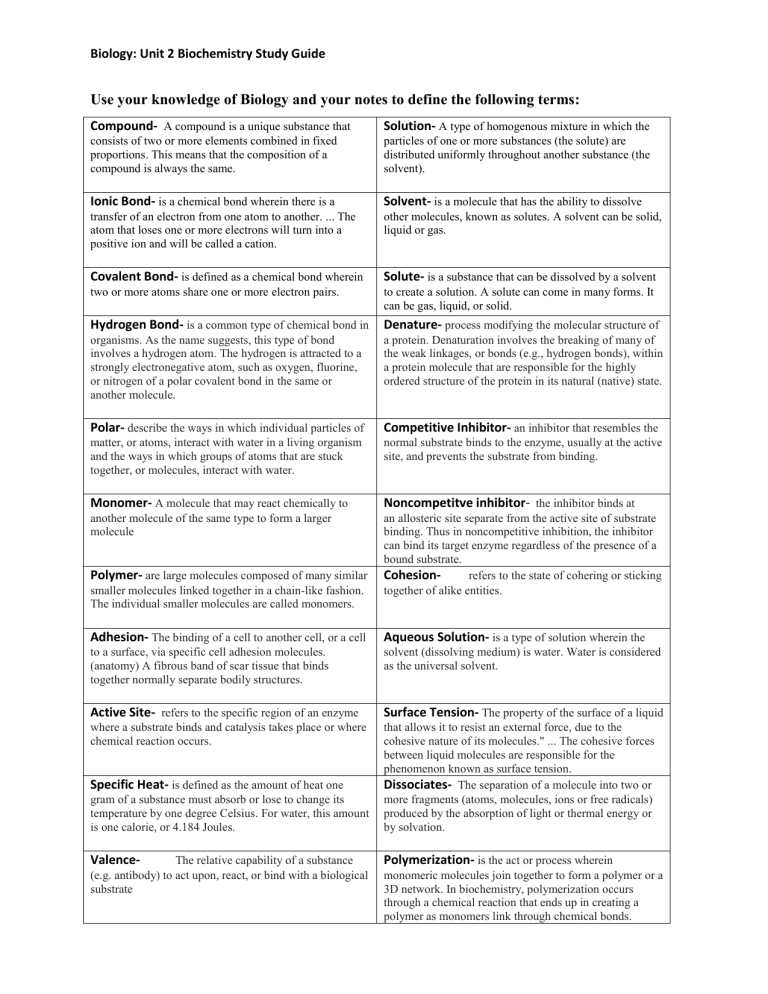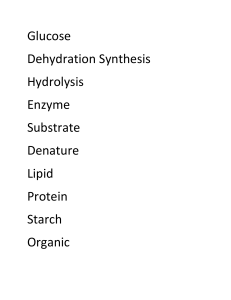
Biology: Unit 2 Biochemistry Study Guide Use your knowledge of Biology and your notes to define the following terms: Compound- A compound is a unique substance that Solution- A type of homogenous mixture in which the consists of two or more elements combined in fixed proportions. This means that the composition of a compound is always the same. particles of one or more substances (the solute) are distributed uniformly throughout another substance (the solvent). Ionic Bond- is a chemical bond wherein there is a Solvent- is a molecule that has the ability to dissolve transfer of an electron from one atom to another. ... The atom that loses one or more electrons will turn into a positive ion and will be called a cation. other molecules, known as solutes. A solvent can be solid, liquid or gas. Covalent Bond- is defined as a chemical bond wherein Solute- is a substance that can be dissolved by a solvent two or more atoms share one or more electron pairs. to create a solution. A solute can come in many forms. It can be gas, liquid, or solid. Hydrogen Bond- is a common type of chemical bond in Denature- process modifying the molecular structure of organisms. As the name suggests, this type of bond involves a hydrogen atom. The hydrogen is attracted to a strongly electronegative atom, such as oxygen, fluorine, or nitrogen of a polar covalent bond in the same or another molecule. a protein. Denaturation involves the breaking of many of the weak linkages, or bonds (e.g., hydrogen bonds), within a protein molecule that are responsible for the highly ordered structure of the protein in its natural (native) state. Polar- describe the ways in which individual particles of Competitive Inhibitor- an inhibitor that resembles the matter, or atoms, interact with water in a living organism and the ways in which groups of atoms that are stuck together, or molecules, interact with water. normal substrate binds to the enzyme, usually at the active site, and prevents the substrate from binding. Monomer- A molecule that may react chemically to Noncompetitve inhibitor- the inhibitor binds at another molecule of the same type to form a larger molecule an allosteric site separate from the active site of substrate binding. Thus in noncompetitive inhibition, the inhibitor can bind its target enzyme regardless of the presence of a bound substrate. Cohesionrefers to the state of cohering or sticking together of alike entities. Polymer- are large molecules composed of many similar smaller molecules linked together in a chain-like fashion. The individual smaller molecules are called monomers. Adhesion- The binding of a cell to another cell, or a cell Aqueous Solution- is a type of solution wherein the to a surface, via specific cell adhesion molecules. (anatomy) A fibrous band of scar tissue that binds together normally separate bodily structures. solvent (dissolving medium) is water. Water is considered as the universal solvent. Active Site- refers to the specific region of an enzyme Surface Tension- The property of the surface of a liquid where a substrate binds and catalysis takes place or where chemical reaction occurs. gram of a substance must absorb or lose to change its temperature by one degree Celsius. For water, this amount is one calorie, or 4.184 Joules. that allows it to resist an external force, due to the cohesive nature of its molecules." ... The cohesive forces between liquid molecules are responsible for the phenomenon known as surface tension. Dissociates- The separation of a molecule into two or more fragments (atoms, molecules, ions or free radicals) produced by the absorption of light or thermal energy or by solvation. Valence- Polymerization- is the act or process wherein Specific Heat- is defined as the amount of heat one The relative capability of a substance (e.g. antibody) to act upon, react, or bind with a biological substrate monomeric molecules join together to form a polymer or a 3D network. In biochemistry, polymerization occurs through a chemical reaction that ends up in creating a polymer as monomers link through chemical bonds. Biology: Unit 2 Biochemistry Study Guide Use your knowledge of Biology and your notes to answer the following questions: Atoms and Bonds 1. ____Matter__________ comprises everything. 2. What does all matter, which comprises all non-living and living material, have in common? All matter is comprised of elements (atoms). 3. Which elements does all living matter consist of? There are 6 elements that make up 96% of the mass of living things! Carbon, Hydrogen, Nitrogen, Oxygen, Phosphorus, Sulfur 4. What elements make something organic? Hydrogen, Carbon, Oxygen 5. What does inorganic mean? Carbon dioxide molecule 6. What is the smallest part of an element? Atom 7. What is inside of the nucleus? It contains most of an atom’s mass 8. What particle of an atom is positively charged and determines the atomic number? the number of protons determines the atomic number. 9. What particle of an atom is neutral and can vary in number among atoms creating different isotopes of an element? Neutron 10. Atomic mass = _ of an atom is found by adding the number of protons and neutrons._ 11. What high-energy particle of an atom is negatively charged to balance the protons positive charge? Electron Water 1. How does cohesion of water molecules work? Hydrogen bonding between the positively charged hydrogen (H+) and negatively charged oxygen (O-) (opposites attract or polarity) of another water molecule making it as if water forms a web. 2. Give an example of cohesion. Each water molecule can form four hydrogen bonds with neighbor molecules. 3. How does adhesion of water molecules occur? Hydrogen bonding between the positively charged hydrogen (H+) of water and another substances molecules Biology: Unit 2 Biochemistry Study Guide making water climb, resulting in capillary action. A water drop is composed of water molecule that like to stick together and example of the property of cohesion. 4. Give an example of adhesion. Pine needles above, the water droplets are stuck to the end of the pine needles-an example of the property of adhesion. 5. How does water change states? Hydrogen bonds are formed to bring together a solid or break apart into a liquid or a gas. 6. Why is water considered the universal solvent of life? Because it is able to dissolve most other substances. Example: Water (Dissolver or Solvent) and Salt (Dissolved or Solute) 7. What is the solvent in salt water? The water 8. What is the solute in salt water? The salt 9. Is water polar or nonpolar? It is polar Macromolecules 1. What are the elements that make up carbohydrates? C, H and O 2. What is the importance of carbohydrates? Primary and quickest Source of Energy for Cell Activity and Storage (Starch) 3. What are the monomers of carbohydrates? Glycerol and Three fatty Acids (Triglycerides) / Glucose and Fructose 4. What are examples of carbohydrates? Saccharides (Sugars): Glucose (mono-plant), fructose (mono-fruit), sucrose (di-table), lactose (poly-milk), cellulose (poly-cell wall), Chitin (poly-shells) (i.e. sugars usually end in-ose) 5. What are the monomers of lipids? Glycerol and Three fatty Acids (Triglycerides) 6. What is the importance of lipids? : Major Source of Energy and Long Term Storage (Glucagon), and Primary Component of the Cell Membrane (Phospholpid) and Insulation 7. What are examples of lipids? Fats (solid at room temperature-1 bond between C (saturated), Oils (liquid at room temperature-at least 1 double bond between C (polyunsaturated), Waxes, and Steroids 8. What are the monomers of proteins? Amino Acids Biology: Unit 2 Biochemistry Study Guide 9. What is the importance of proteins? Catalyzes (Supports) and Speeds-Up Chemical Reactions (Enzymes) and Transport Molecules Through and Provide Structural Support for the Cell Membrane 10. What are examples of proteins? Enzymes, Hemoglobin, Antibodies, Collagen, and Keratin 11. What are the monomers of nucleic acids? Nucleotides (Five-Carbon Sugar Phosphate Group, and a Nitrogenous Base) 12. What are examples of nucleic acids? DNA, RNA, tRNA 13. What is the importance of nucleic acids? Stores Genetic Information and Directs the Synthesis (Production) of Proteins 14. pH 1. Draw the pH scale below. Make sure to include the following: Where H+ ions are located, where OH- ions are located, which are acids, which are bases, draw arrows of the direction of increasing acidity, draw arrows of the direction of increasing basicity, label where neutral is, include all of the numbers on the pH scale. 2. Each pH is ____10________times ____stronger______________ than the next. 3. A pH of 1 is ____10 times stronger____________ than a pH of 2. 4. Of the following examples, list whether they are an acid, a base, or neutral. And if they are strong or weak!!! Biology: Unit 2 Biochemistry Study Guide a. pH 4: ______acid_____________ b. pH 9: ____base_______________ c. pH 2: ____acid_______________ d. pH 6: _____acid______________ e. pH 1: _____acid______________ f. pH 7: _____neutral______________ g. pH 14: ___base______________ 5. What is a buffer? A solution that does not change pH when an acid or base is added. Enzymes 1. What macromolecule group do enzymes belong in? Proteins 2. Do enzymes slow down or speed up chemical reactions? By enzymes (proteins) which are biological catalysts that speed up chemical reactions by lowering its activation energy by weakening bonds. 3. Is the following picture breaking down or building up chemical reaction? Breaking Down-Hydrolysis 4. Is the following picture breaking down or building up chemical reaction? Building-UpDehydration Synthesis 5. Biology: Unit 2 Biochemistry Study Guide 6. How does a chemical reaction affect the enzyme and the substrates? 7. Draw and label: an enzyme, substrate, and an enzyme-substrate complex. Also, label where you would find the active site. 8. How does temperature effect enzyme activity? High temperatures can destroy enzymes, therefore decreasing enzyme activity. As temperature increases, enzyme activity increases up to a point and then decreases. 9. How does pH effect enzyme activity? Enzymes work at specific pH (most function best at a pH between 6-8). Changing the pH can destroy the enzyme, therefore decreasing enzyme activity. As pH increases, enzyme activity increases up to a point and then decreases. 10. Why does enzyme activity begin to decrease when exposed to high temperatures and high or low pH? The enzyme loses its shape (it denatures), and changing its’ shape unfolds it and keeps enzymes from functioning.




